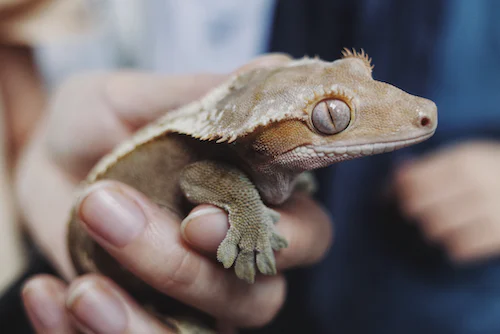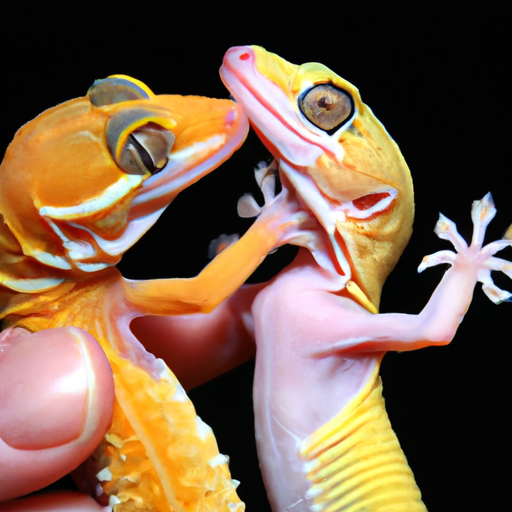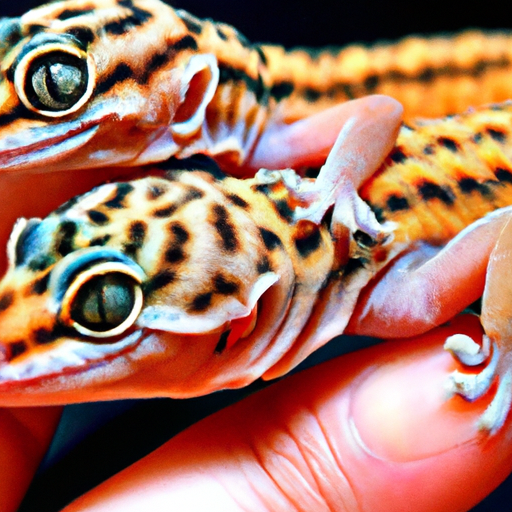
Geckos, those fascinating reptiles known for their distinctive ability to climb walls and ceilings, have captivated pet owners worldwide. But are geckos social pets? This article aims to shed light on the often misunderstood behavior of these remarkable creatures. By examining their natural habitat, communication methods, and social interactions, you will gain a deeper understanding of whether geckos make suitable companions for those seeking a social pet. Discover the intriguing world of geckos and unravel the enigma surrounding their social tendencies.

Types of Geckos
Common Leopard Gecko
The Common Leopard Gecko (Eublepharis macularius) is one of the most popular gecko species kept as pets. They are native to arid regions of Pakistan and India and are known for their distinctive spotted pattern. These geckos are solitary in nature and prefer to live alone. They are relatively easy to care for and have a calm temperament, making them a great choice for beginner reptile enthusiasts.
Crested Gecko
The Crested Gecko (Correlophus ciliatus) is a unique and charming gecko species native to New Caledonia. They are known for their crested appearance and their ability to climb walls and trees using their specialized toe pads. Crested geckos are mainly arboreal and active during the night. They often tolerate handling well and can become quite bonded with their owners. Due to their social nature, they can also be housed together in small groups under the right conditions.
African Fat-Tailed Gecko
The African Fat-Tailed Gecko (Hemitheconyx caudicinctus) shares a similar appearance to the Common Leopard Gecko, but its tail is fatter and shorter. These geckos are native to West Africa and are nocturnal in nature. They are generally more solitary and territorial compared to other gecko species. Although they can tolerate some handling, they may exhibit defensive behaviors if they feel threatened. It is important to provide them with a suitable habitat that includes hiding spots to minimize stress.
Gargoyle Gecko
The Gargoyle Gecko (Rhacodactylus auriculatus), also known as the New Caledonian Bumpy Gecko, is a fascinating and unique gecko species native to New Caledonia. They get their name from the bumpy texture on their skin, resembling the appearance of gargoyles. These geckos are primarily arboreal and enjoy climbing branches and vines. They are primarily solitary and may become stressed if housed with other geckos. Gargoyle geckos are known for their docile temperament and are often considered good pets for beginners.
Day Gecko
Day Geckos belong to the genus Phelsuma and consist of many different species, each with its unique characteristics. These geckos are known for their vibrant colors, quick movements, and ability to climb walls and foliage. Unlike many other gecko species, Day Geckos are diurnal, meaning they are active during the day. They are highly territorial and tend to be aggressive towards other geckos. Day Geckos require specific habitat conditions, including UVB lighting and a well-maintained temperature gradient.
Natural Behavior of Geckos
Nocturnal Habits
Geckos are generally nocturnal, meaning they are most active during the night. This behavior is primarily due to their need to avoid extreme heat and predators. They have adapted to low-light conditions and possess specialized eye structures that allow them to see clearly in dim light. Nocturnal geckos have evolved to hunt for their prey, such as insects, during the night when their food sources are more readily available.
Solitary by Nature
Most gecko species are solitary by nature and prefer to live alone. This behavior is rooted in their need to secure resources, such as food, water, and suitable shelter. In the wild, geckos establish territories and defend them against intruding individuals. Solitary behavior allows them to minimize competition for limited resources and reduce the risk of aggressive encounters. In captivity, it is essential to provide each gecko with its own enclosure to ensure their well-being and prevent unnecessary stress.
Territorial Defense
Geckos are known to be territorial and will actively defend their designated areas from intruders, including other geckos. Territorial disputes can lead to aggressive behaviors, such as biting and tail-waving. These behaviors are aimed at asserting dominance and enforcing boundaries. In the wild, territorial defense helps geckos establish and maintain their access to essential resources. When keeping geckos as pets, it is crucial to provide each gecko with sufficient space and resources to avoid territorial conflicts.
Communication Methods
Geckos utilize various communication methods to interact with their surroundings and with other geckos. One common communication method is through vocalizations. While geckos are generally not vocal, some species, such as the Tokay Gecko, can produce distinctive chirping or barking sounds. These sounds serve as territorial calls or mating calls. Additionally, geckos use body language, such as tail waving and posturing, to communicate their intentions and establish dominance. Scent marking is another important communication method, allowing geckos to leave chemical signals behind to mark their territory or attract mates.
Geckos and Human Interaction
Limited Bonding
Geckos, in general, do not form strong emotional bonds with humans like some other pets do. They do not seek out human affection or form deep attachments. However, many gecko enthusiasts report that individual geckos can become familiar with their owners over time and may tolerate human presence. This limited bonding is often attributed to geckos associating human interaction with positive experiences, such as feeding.
Tolerance of Handling
While geckos are not typically pets that enjoy being handled, some species, such as Crested Geckos, can tolerate gentle handling if introduced to it from a young age. It is important to remember that individual geckos may have different temperaments, and some may be more receptive to handling than others. When handling a gecko, it is crucial to approach them slowly and gently to minimize stress and potential injury.
Recognizing Familiar Individuals
Geckos have the ability to recognize familiar individuals, including their owners. This recognition is often based on visual and olfactory cues. By consistently interacting with your gecko and providing them with food and care, you can establish a sense of familiarity and trust. It is important to note that recognition may vary between individuals and not all geckos will respond in the same way.
Observing Social Interactions
Although geckos are primarily solitary, observing their social interactions can still provide valuable insights into their behavior and natural instincts. For example, if multiple geckos are housed together, you may notice subtle interactions such as territory marking, displays of dominance, or submissive behaviors. By allowing geckos to interact within controlled and appropriate settings, you can gain a better understanding of their social dynamics.
Social Behavior Variation
Species Differences
Each gecko species has unique social behaviors and requirements that are influenced by their natural habitats and evolutionary adaptations. Some species, like Crested Geckos, have shown the ability to tolerate group living and even exhibit social behaviors. On the other hand, species like Common Leopard Geckos are predominantly solitary and prefer to live alone. It is important to research and understand the social behavior of the specific gecko species you plan on keeping as a pet to provide suitable care.
Individual Personalities
Just like humans, geckos can have individual personalities. Within a species, some geckos may be more docile, while others may exhibit more aggressive or defensive tendencies. These individual differences can affect their social behavior and their responses to human interaction. Observing and understanding your gecko’s unique personality traits can help you tailor their care and create an enriched environment.
Environmental Factors
Environmental factors, such as habitat quality and availability of resources, can influence gecko social behavior. In areas where resources are scarce, geckos may exhibit more territorial behaviors and be less tolerant of other individuals. Conversely, in environments with abundant resources, some gecko species may exhibit more social behaviors and tolerate the presence of conspecifics. Understanding the natural habitat of a gecko species can provide insights into their social behavior and guide their care in captivity.
Group Living Possibilities
While most gecko species are solitary, some species show a potential for group living under the right conditions. Crested Geckos, for example, have been observed living together in small groups in their natural habitat. When kept in a suitable environment with adequate space and resources, Crested Geckos can be housed together. It is vital to closely monitor the social dynamics within the group to ensure the well-being of each individual and intervene if necessary.

Gecko Group Living
Exceptions to Solitary Behavior
Although most gecko species are solitary, there are exceptions where group living occurs. As mentioned earlier, Crested Geckos have been observed living in small groups in their natural habitat. This social behavior is thought to have evolved to maximize access to resources and reduce predation risk. However, it is important to note that not all individuals of a species may be suited for group living, and housing geckos together should be done cautiously and with careful consideration.
Observation of Group Interactions
If housing geckos together, observing their group interactions is crucial. Geckos may establish dominance hierarchies within the group, which can be observed through behaviors such as posturing, tail wagging, or chasing. Some individuals may exhibit more submissive behaviors, such as avoiding conflict or retreating. Monitoring these interactions helps ensure that all geckos within the group are behaving appropriately and not showing signs of stress or aggression.
Benefits of Being Social
Social living can provide certain benefits to geckos. For instance, being in a group can reduce individual stress levels and provide a sense of security. Group living can also facilitate the sharing of resources, such as food and shelter, which can be advantageous in environments where these resources are limited. Additionally, social interactions within a group can provide mental stimulation and enrichment, contributing to the overall well-being of geckos.
Challenges of Group Living
While there are potential benefits to group living, there are also challenges that need to be addressed. Increased competition for resources, such as food and territory, can lead to aggression and stress within the group. Inadequate space or insufficient resources can result in dominant individuals excluding others and causing social imbalances. It is essential to provide a suitable habitat that caters to the needs of multiple geckos while minimizing potential conflicts.
Socialization Techniques
Habitat Enrichment
Habitat enrichment plays a crucial role in socializing geckos and promoting their overall well-being. Providing a diverse and stimulating environment can mimic aspects of their natural habitat and encourage social behaviors. This can include adding live or artificial plants, various climbing structures, and different textures throughout the enclosure. Creating a complex habitat with hiding spots and vertical spaces allows geckos to establish territories while still providing opportunities for social interaction.
Environmental Mimicry
To encourage social behavior, it can be beneficial to mimic aspects of a gecko’s natural environment within their enclosure. This can include providing temperature gradients, adequate humidity levels, and appropriate lighting conditions. By replicating their native habitat, geckos may feel more comfortable and exhibit behaviors that resemble their natural social interactions.
Providing Hiding Spots
Hiding spots are essential for geckos as they provide a sense of security and privacy. Adequate hiding spots should be provided to allow geckos to retreat and establish their territories within their enclosure. These hiding spots can be created using natural materials such as cork bark, rock formations, or artificial structures designed for hiding purposes. Ensuring that each gecko has access to its own hiding spot helps minimize stress and potential conflicts.
Feeding and Enclosure Strategies
When socializing geckos, it is important to consider their feeding and enclosure strategies. Providing multiple feeding stations throughout the enclosure allows each gecko to access food without conflict or competition. Additionally, offering a variety of food items and feeding methods can stimulate their natural foraging behavior and encourage social interactions. Ensuring that each gecko has equal access to resources promotes a balanced environment.
Geckos as Territorial Pets
Territorial Marking and Display Behaviors
Geckos display territorial behaviors through both visual displays and scent marking. Visual displays can include posturing, tail-waving, and body movements aimed at asserting dominance and communicating territorial ownership. Scent marking, on the other hand, involves the use of specialized glands to release pheromones or other scents to mark territories or attract mates. Understanding these territorial markings and display behaviors can help owners manage gecko interactions and establish appropriate boundaries.
Protective Aggression
Geckos, especially males, may exhibit protective aggression when defending their territory or during mating season. This aggressive behavior can include biting, chasing, and tail-waving towards conspecifics or perceived threats. Owners should be mindful of these aggressive displays and ensure their geckos are provided with adequate space and resources to minimize potential confrontations.
Understanding and Managing Territory
Managing gecko territory is essential for maintaining a healthy and stress-free environment. Providing each gecko with its own enclosure is crucial to prevent territorial conflicts. Enclosures should be spacious enough to allow geckos to establish territories and include appropriate hiding spots. When introducing new geckos, gradual introductions and monitoring of social interactions should be done to ensure compatibility and minimize territorial disputes.
Communication Signals
Vocalizations
While geckos are generally not known for their vocalizations, some species may produce sounds as part of their communication repertoire. For instance, the Tokay Gecko (Gekko gecko) is well-known for its loud and distinctive “tokay” call, which acts as a territorial or mating vocalization. Other gecko species may produce softer chirping or barking sounds. Vocalizations can play a role in maintaining territories, attracting mates, or warning off potential threats.
Body Language
Geckos utilize body language to communicate their intentions and establish dominance. Tail wagging, posturing, and certain body movements can convey messages to other geckos. For example, a gecko may raise its body and lunge forward as a sign of aggression, while a submissive gecko may flatten its body and expose its underside. Understanding these body language cues can help owners interpret their gecko’s behavior and respond accordingly.
Scent Marking
Scent marking is another important communication signal in geckos. Geckos possess specialized glands that release pheromones or other chemical signals to mark territories and attract mates. By leaving scent markings on surfaces or objects within their environment, geckos can communicate their presence and assert dominance. Scent marking can help minimize direct confrontations between geckos by providing an indirect means of communication.

Geckos and Other Pets
Interaction with Other Geckos
Geckos can interact with conspecifics in various ways, depending on the species and individual factors. Some gecko species, such as Crested Geckos, have shown the potential for positive social interactions and even tolerate being housed together. However, it is essential to closely monitor gecko interactions to ensure compatibility and prevent territorial disputes. Introducing geckos gradually and providing adequate space and resources can help facilitate positive interactions.
Compatibility with Different Reptiles
When considering housing geckos with other reptiles, it is crucial to research and consider the specific requirements and behaviors of each species involved. Not all reptiles are compatible with geckos, and some may pose a risk to their well-being. For example, larger reptiles with predatory instincts may view geckos as prey. It is important to seek expert advice and carefully assess compatibility to prevent potential harm to geckos or other reptiles.
Potential Risks and Concerns
Introducing geckos to other pets, such as cats or dogs, should be done with extreme caution. Predatory instincts from cats and dogs can pose significant risks to the safety and well-being of geckos. Even with supervision, it is generally recommended to keep geckos and predatory pets separate to ensure their safety.
Can Geckos Be Kept in Pairs or Groups?
Considerations for Housing Multiple Geckos
While some gecko species can be housed together in small groups, there are several considerations to keep in mind. First, it is important to research the specific social behavior of the gecko species you plan on keeping. Some species, like Crested Geckos, have shown more tolerance for group living, while others are more solitary and may become stressed by the presence of conspecifics. Additionally, providing adequate space, hiding spots, and resources is essential to minimize territorial disputes and ensure the well-being of all geckos in the group.
Success and Challenges of Keeping Geckos Together
Keeping geckos together can be successful if the appropriate conditions are met. By closely monitoring their interactions, providing sufficient resources, and carefully selecting compatible individuals, geckos can live harmoniously in a group setting. However, challenges can arise, such as social hierarchies, territorial conflicts, and the potential for injuries. Owners must be prepared to intervene if necessary and provide a suitable environment that promotes positive social interactions.
Creating a Suitable Multi-Gecko Environment
Creating a suitable environment for multiple geckos involves careful planning and consideration. Each gecko should have enough space to establish its own territory, access to hiding spots, and sufficient resources. The enclosure should have appropriate temperature and humidity gradients to accommodate the needs of all geckos within the group. Regular monitoring of social dynamics and behavior is crucial to ensure that all geckos are thriving and that any issues can be addressed promptly.

